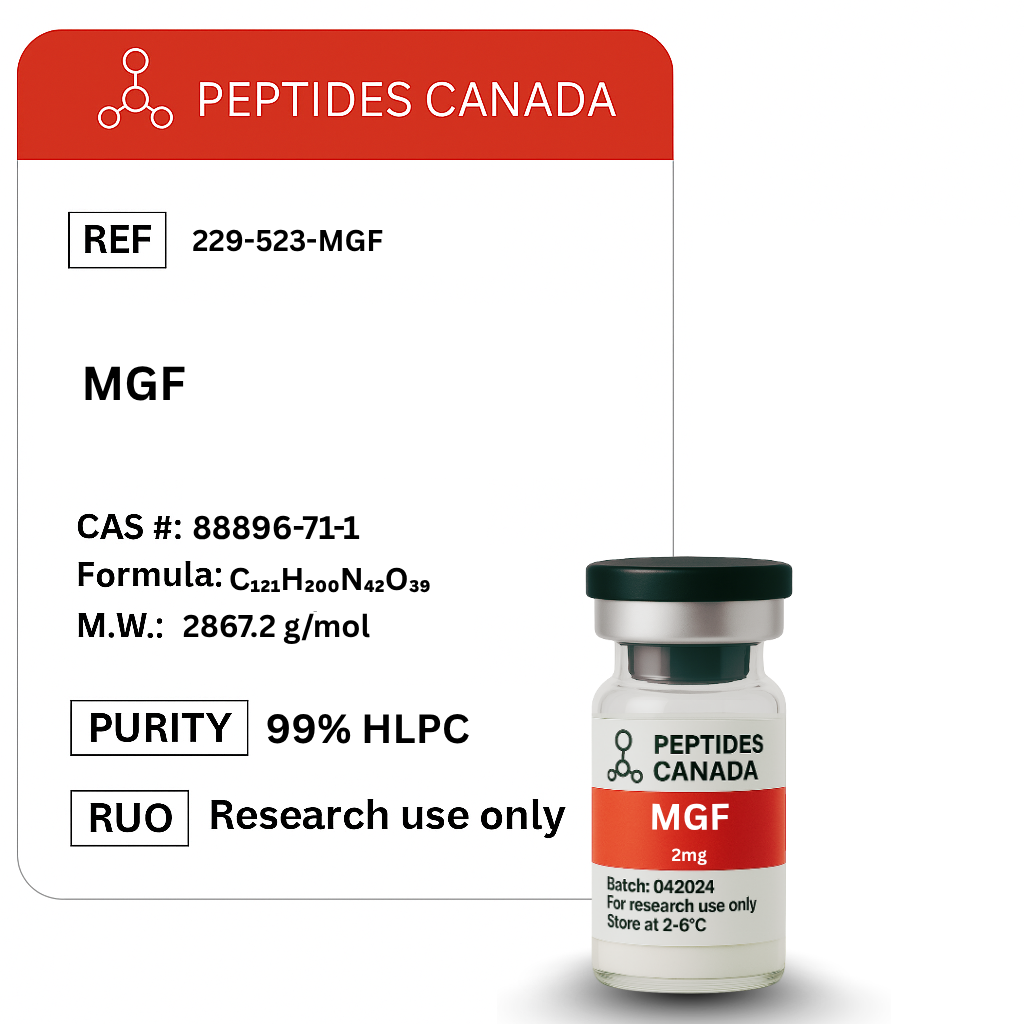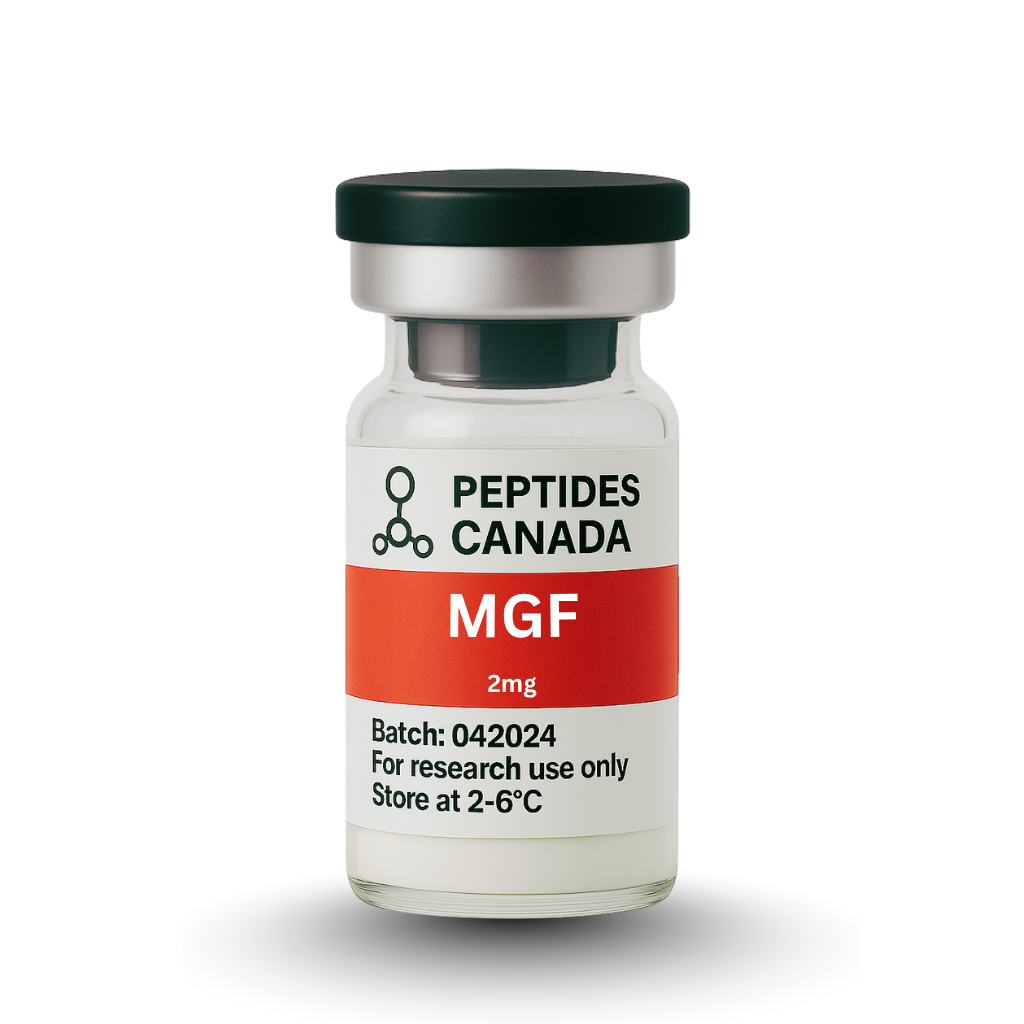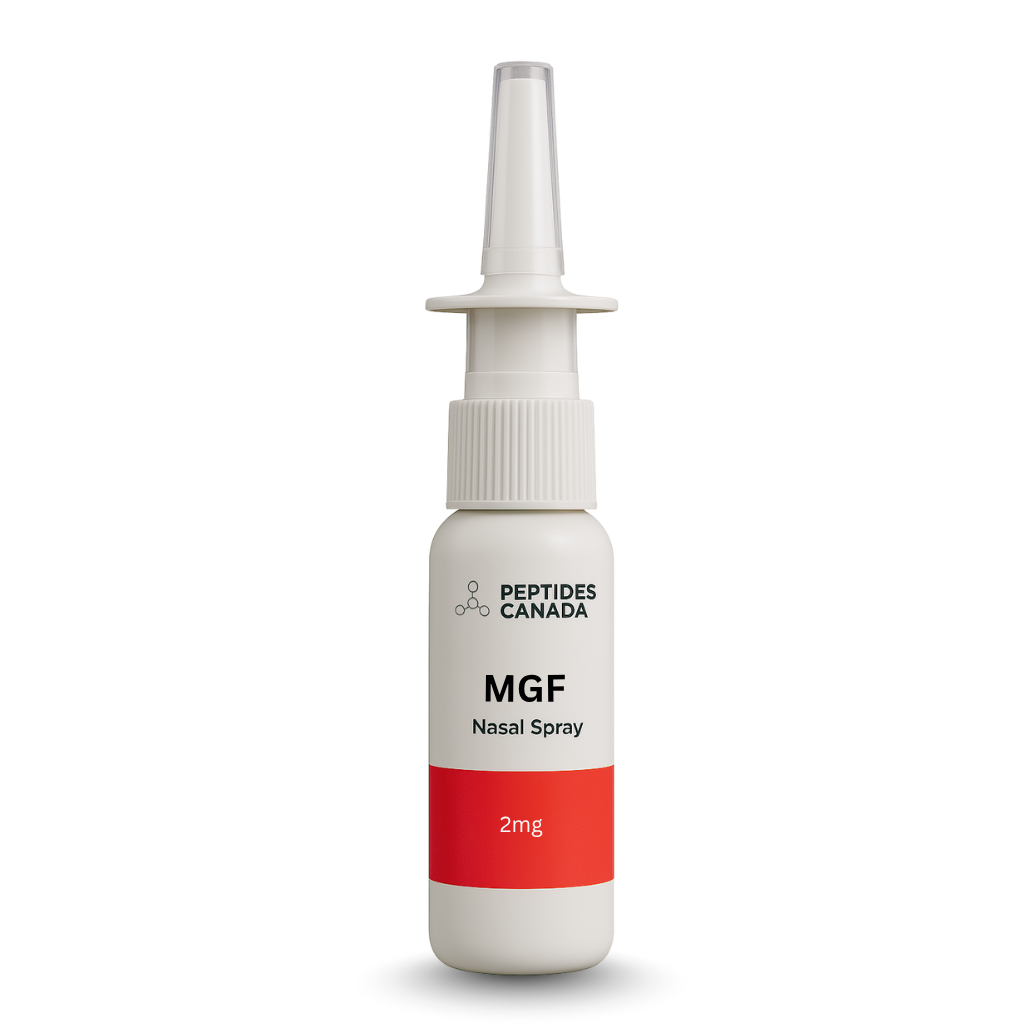MGF
From CAD $38 CAD $39
Contents: MGF (Mechano Growth Factor, IGF-1 Splice Variant)
Form: Powder
Purity: 99.3%
TESTED FOR:
- PURITY
- STERILITY
- WEIGHT
- ENDOTOXINS(LPS)
Free Reconstitution solution automatically added to your cart with each order of vial.
This product is Made, Tested & Shipped From Canada.
Ships Today
Order by 1:00 PM EST
Free Shipping
For 2 or more vials
99%+ Purity Guaranteed
COA Verified+
Trackable Shipping
MGF Peptide
Mechano Growth Factor (MGF) is a naturally occurring splice variant of the insulin-like growth factor-1 (IGF-1) gene, expressed in response to mechanical stress or muscle damage. It is a synthetic peptide corresponding to the unique E-domain of the IGF-1 gene transcript, comprising 24 amino acids. Researchers suggest that MGF may play a role in the activation and proliferation of satellite cells, which are key to muscle repair and regeneration processes in experimental systems.
In laboratory studies, MGF has been observed to initiate autocrine and paracrine signaling cascades distinct from those mediated by systemic IGF-1. The peptide’s localized expression following mechanical loading or muscle injury has led to investigations into its potential role in tissue repair, neuroprotection, and recovery from cellular stress.
Overview
IGF-1 is known to exist in multiple isoforms arising from alternative splicing of the IGF-1 gene. Among these, MGF (IGF-1Ec in human sequence nomenclature) contains a unique E-domain sequence that differentiates it functionally from other IGF-1 variants. Research indicates that while systemic IGF-1 promotes cell differentiation and growth, MGF may primarily influence progenitor cell activation and tissue remodeling at the site of mechanical strain.
MGF expression has been reported to increase significantly following eccentric exercise, mechanical load, or injury-induced stress. In experimental conditions, MGF appears to act through PI3K/Akt and MAPK pathways, which are implicated in cellular survival, growth, and anti-apoptotic signaling. Studies have also proposed that MGF may exhibit neuroprotective effects in neuronal cell models, potentially reducing apoptosis and promoting axonal regeneration.
Synthetic MGF peptides are used in laboratory research to investigate the mechanisms underlying muscle hypertrophy, tissue repair, and neuroregeneration. Their stability and bioavailability are determined largely by sequence optimization and the prevention of rapid enzymatic degradation in vitro.
Chemical Makeup
- Form: Lyophilized Powder
- Contents: Mechano Growth Factor (IGF-1Ec fragment)
- Molecular Formula: C121H200N42O39
- Molecular Weight: 2888.16 g/mol
- Batch Purity: 99.3% (COA verified)
- Formulation Size: 2 mg per vial
Research and Experimental Findings
MGF and Skeletal Muscle Regeneration
Experimental models demonstrate that MGF expression increases following muscle overload and mechanical stimulation. The peptide has been reported to stimulate satellite cell proliferation while delaying premature differentiation, potentially enhancing the regenerative capacity of skeletal muscle tissue.
MGF and Neuroprotection
In neuronal models, MGF has been observed to activate cell survival pathways associated with Akt phosphorylation, reducing apoptosis induced by oxidative or ischemic stress. These findings have led to further studies on the peptide’s possible role in neuronal recovery and axon outgrowth.
MGF and Cellular Repair Mechanisms
MGF may upregulate genes involved in cell-cycle progression, DNA synthesis, and anti-apoptotic regulation. In vitro research suggests that MGF-treated cells exhibit enhanced proliferation and repair efficiency compared to controls, indicating potential signaling distinct from systemic IGF-1 activity.
MGF and Cardiac Studies
Preclinical studies on cardiac tissue have shown transient MGF expression after myocardial injury. Researchers propose that the peptide may play a supportive role in cardiac tissue repair and cytoprotection through modulation of survival signaling pathways and fibroblast activity.
MGF and Age-Related Decline
MGF expression has been found to diminish with age in various models, potentially correlating with reduced muscle mass and regenerative ability. Experimental administration of synthetic MGF in aging models has been investigated for its ability to stimulate local IGF signaling and muscle stem cell activation.
Mechano Growth Factor peptide is available for research and laboratory purposes only. It is not intended for human or animal therapeutic use.
References
- Yang SY, Goldspink G. Different roles of the IGF-I Ec peptide (MGF) and mature IGF-I in myoblast proliferation and differentiation. FEBS Lett. 2002;522(1-3):156–160. https://pubmed.ncbi.nlm.nih.gov/12095628/
- McKoy G, Ashley W, Mander J, Yang SY, Williams N, Russell B, Goldspink G. Expression of IGF-1 splice variants and structural genes in rabbit skeletal muscle induced by stretch and stimulation. J Physiol. 1999;516(Pt 2):583–592. https://pubmed.ncbi.nlm.nih.gov/10087355/
- Goldspink G. Mechanical signals, IGF-I gene splicing, and muscle adaptation. Physiology (Bethesda). 2005;20:232–238. https://pubmed.ncbi.nlm.nih.gov/16024513/
- Owino V, Yang SY, Goldspink G. Age-related loss of skeletal muscle function and the role of MGF splice variant of IGF-1. J Musculoskelet Neuronal Interact. 2001;2(3):195–198. https://pubmed.ncbi.nlm.nih.gov/15758434/
- Mills P, Nader GA. Regulation of muscle stem cell fate by IGF-1 and MGF signaling. Exp Gerontol. 2006;41(12):1114–1121. https://pubmed.ncbi.nlm.nih.gov/16996213/
- Ramer MS, Priestley JV, McMahon SB. Functional regeneration of sensory axons into the adult spinal cord. Nature. 2000;403(6767):312–316. https://pubmed.ncbi.nlm.nih.gov/10659854/
- Kandalla PK, Goldspink G, Butler-Browne G, Mouly V. Mechano Growth Factor activates human muscle progenitor cells and modulates their differentiation. J Cell Physiol. 2011;226(7):1743–1750. https://pubmed.ncbi.nlm.nih.gov/20945333/
- Quesada A, Etayo-Labiano I, Villalba M, et al. Mechano-growth factor and IGF-I receptor signaling in neuroprotection. J Neurosci Res. 2007;85(10):2139–2148. https://pubmed.ncbi.nlm.nih.gov/17549746/
- Mills P, Goldspink DF, et al. MGF and the adaptive response to mechanical loading in skeletal muscle. Biochem Soc Trans. 2003;31(Pt 6):1191–1196. https://pubmed.ncbi.nlm.nih.gov/14641011/
- Zhao J, Li X, et al. Expression of mechano-growth factor after myocardial infarction and its effect on cardiomyocyte apoptosis. Biochem Biophys Res Commun. 2009;382(3):580–584. https://pubmed.ncbi.nlm.nih.gov/19280612/
- Hameed M, Lange KH, Andersen JL, Schjerling P, Kjaer M, Harridge SD. The effect of recombinant human growth hormone and resistance training on IGF-I splice variant expression in older men. J Physiol. 2004;555(Pt 1):231–240. https://pubmed.ncbi.nlm.nih.gov/14678489/
- McMahon CD, Popovic L, Oldham JM, Jeanplong F, Osepchook CC, Hodgkinson SC, Sheard PW, Dixon MW, Knowles SE, Bass JJ. GH dependence of skeletal muscle IGF-I and MGF mRNA expression. Am J Physiol Endocrinol Metab. 2003;284(4):E671–E678. https://pubmed.ncbi.nlm.nih.gov/12475752/
- Yang SY, Alnaqeeb M, Simpson H, Goldspink G. Cloning and characterization of an IGF-I isoform expressed in skeletal muscle subjected to stretch. J Muscle Res Cell Motil. 1996;17(4):487–495. https://pubmed.ncbi.nlm.nih.gov/8884600/
- Philippou A, Halapas A, Maridaki M, Koutsilieris M. Type I IGF-1 Ec (MGF) expression in exercising skeletal muscle. Histol Histopathol. 2007;22(6):603–618. https://pubmed.ncbi.nlm.nih.gov/17357089/
- Quesada A, Romeo HE, Micevych P. IGF-1 and MGF expression in hippocampal neurons: neuroprotective role in aging. Neuroscience. 2009;162(1):64–73. https://pubmed.ncbi.nlm.nih.gov/19374946/
For research use only. Not for human or veterinary use.
HIGHEST QUALITY PEPTIDES
Our products are scientifically formulated and manufactured in cGMP-compliant facilities.
FAST DELIVERY
Enjoy fast and reliable 3–5 day shipping.
Dedicated Customer Service
Our customer service team is highly knowledgeable in peptide research and its applications. We’re available 24/7 to assist you.
Tested. Verified. Trusted.
We take a laboratory-first approach to quality. Each batch is made under controlled conditions and verified by an independent lab (HPLC/MS). We only ship batches that test ≥99% purity, and we provide a full COA, including identity, methods, and chromatograms, for your review.
See the Process for Yourself
We make our peptides in our own cGMP lab. Watch the video to see how every vial is produced, tested, and handled with care.
Science Behind Our Peptides
A clear explanation of how our peptides work, their benefits, why quality matters for best results, and what you should know.
Categories
Categories
How do I know the peptides I order are exactly what the label says?
Every vial we sell comes from a lab that follows current Good Manufacturing Practices (cGMP). That means each step of production is documented and controlled. Before a batch is released, it’s tested by independent third-party labs for purity, identity, and sterility. Certificates of analysis are available so you can see the exact test results.
Are your peptides produced in a sterile and controlled environment?
Yes. The labs we work with use ISO-certified clean rooms where air quality, equipment, and handling procedures are tightly regulated. Staff are trained to pharmaceutical-grade standards. This ensures the peptides are produced in an environment that minimizes contamination risks.
What about shipping? Do the peptides remain stable in transit?
Peptides in lyophilized (freeze-dried) form are stable at room temperature for transport. Once you receive them, refrigeration is recommended to maintain long-term integrity. We package every order securely to prevent damage and ship promptly, so your vials arrive in optimal condition.
How do I know you actually make these peptides yourselves?
We operate under strict in-house protocols that follow current Good Manufacturing Practices (cGMP). That means our team oversees the entire process from sourcing raw amino acids to the final lyophilized vial. Nothing is outsourced or repackaged. This gives us full control over purity, consistency, and sterility, and it’s why we can stand behind every single vial we ship.
What should I do with the vials once they arrive?
Store them in the refrigerator, away from direct light and heat. If you need to keep them longer, some peptides can be stored frozen. Each vial comes with clear handling instructions so you know the proper conditions for stability.
What proof do you have that your peptides are legitimate?
The strongest proof is transparency. For every peptide, we can provide certificates of analysis, manufacturing documentation, and references to the published scientific research behind it. If you ever have questions, we’ll show you the data rather than ask you to take our word for it.




